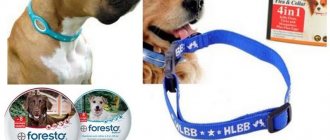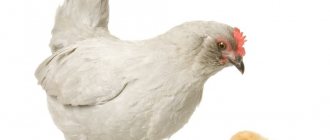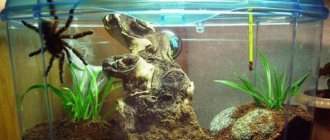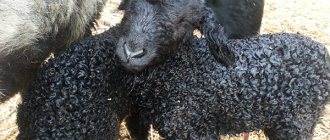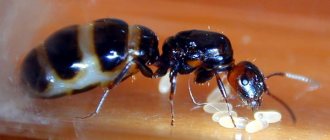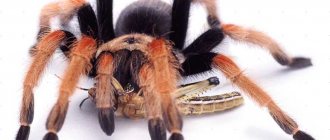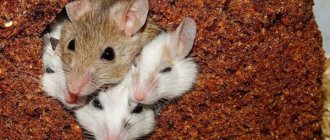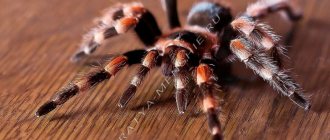Breed selection
The breed should be selected in accordance with the intended purpose of breeding - to obtain meat, fluff or milk. Each breed has its own characteristics and nuances in terms of conditions of maintenance and nutrition.
Dairy
When purchasing dairy cattle, you should pay attention to the following external details:
- head – light and small in size;
- wide chest;
- straight back;
- straight, strong legs;
- an elastic, non-sagging udder (an udder that is too large indicates excess fat deposits and low milk yield);
- developed nipples.
Dairy breeds are capable of producing up to 10 liters of milk per day. Goat's milk is a hypoallergenic product that can be given to children from birth.
Downy
Animals that are bred for fluff and wool are distinguished by the following features in their body structure:
- body size is much larger than that of relatives of other breeds;
- very wide chest;
- straight back and strong limbs;
- wide sacrum and lumbar region;
- small head sizes;
- the coat grows evenly, evenly white;
- the fur on the head is soft, it is better if it falls over the eyes;
- the skin is smooth and does not form folds.
The wool of these goats is of much better quality and is highly valued in markets.
Meat
Goats of this type are kept mainly for meat. Milk is produced in small quantities, usually only enough to feed the young.
Characteristic features are a barrel-shaped round body and a small udder located high. Meat is considered dietary and has a healing effect for diseases of the digestive system, heart, blood vessels and blood diseases.
Decorative
Goats of these breeds are distinguished by their small body size, but at the same time their ability to produce milk. Thanks to their compactness, they can be maintained on a summer cottage of any size. They love to eat large amounts of grass, hay and leaves.
Preliminary preparation
Before bringing the animal to the farm, it is necessary to prepare or build a special room in which the goats will be located, purchase or independently prepare food and provide a sufficient amount of water.
Premises requirements
Goats easily adapt to any weather changes and tolerate cold well. In summer it is better to keep them in a pen outdoors, and in winter - indoors.
Primary requirements:
- Good ventilation. Insufficient fresh air flow negatively affects livestock productivity.
- Space. These are quite active animals, so each adult will require at least 3-4 square meters. meters of area.
- Air temperature and humidity. For the cold season, the temperature should be at least +7-8 °C, and in summer - no more than +18-20 °C. Air humidity is recommended to be maintained at about 60%.
- You need to lay a bedding of hay or straw on the floor.
- The room should be well lit.
- It is better to make a separate extension for the kids.
Feeder and drinker
Proper maintenance and care of goats involves equipping special feeders and drinking bowls.
There are also certain requirements for feeders, as they must be safe for all animals, regardless of their gender and age.
Rules for equipping goat feeders:
- feeding holes must be of such a size that the animal can completely put its head into it and not get stuck there, but at the same time, so that it cannot crawl in there with its legs or completely;
- if the manger is a container without holes, it is better to make a box under it into which the remaining food will fall; it can then be poured back into the rest of the food;
- you need to make a separate compartment for pieces of salt;
- for kids that are kept in the same room with adults, you need to prepare holes at the level of their growth, separating their food from the “adult”;
- the feeder cannot be treated with protective agents, or they must be safe. This is because goats often chew the wooden parts of the feeder, so parts of the paint or other coatings can get into the feed;
- if the feed falls on the floor, the goats will no longer eat it, so you need to take care of the design of the feeder in such a way that the loss of feed will be minimal;
- It is advisable to place feeders on the wall opposite the entrance;
- the feeder should be equipped along the entire width of the wall so that the animals do not crowd, but stand in a row.
In addition to feeders, you need to provide drinking bowls for goats. They can be represented by a bucket or trough. For greater convenience, you can install automated drinking bowls.
Purchasing breeding animals
Before owning goats, you need to decide on your breeding goals and, depending on them, the breed of the animal.
When buying a dairy goat, there are several recommendations to consider:
- a young goat does not produce much milk, usually a good milk supply is noted after the second lambing;
- A healthy individual has 32 teeth and shiny fur;
- For a few days it is better to observe the goat you like, its behavior and character;
- To understand whether the milk will have an unpleasant odor, you need to sniff the animal between the horns - if you don’t feel anything unpleasant, then you will like the milk.
When purchasing, you need to pay attention to the quality characteristics of each individual breed.
You can buy breeding goats on special farms or from private breeders.
Setting up a goat barn
When the main building is built, it is necessary to start arranging the goat house to make it easier to keep livestock:
- Feed containers should be located in a common area and not in separate pens. The feeder is a long trough. It should be hung on the wall so that the animals feel comfortable while eating. It is not a good idea to place feeders on the floor, as goats can carry dirt into their food with their hooves. The length of the trough and the hanging height are calculated taking into account the number and age of the livestock.
- As for drinking bowls, they can be located in each stall; in addition, water must be placed in the pen where the pregnant or lactating queen is located. Buckets can be used as drinking bowls, but children may accidentally knock them over. Therefore, it is better to equip the room with special mechanical drinkers or use hanging buckets.
- Goats like to use high places to sleep. For this purpose, you can place a small bale in each stall for the convenience of the animals. In addition, it will help prevent some health problems.
- To purify the air in the room and eliminate unpleasant odors, the floor surface should have a slight slope. In addition, you need to make a gutter where all liquids will drain. This helps to significantly improve the appearance and condition of the barn, and it will be much more pleasant to keep animals.
- In pens, the floor must be covered with straw bedding. For this purpose, you need to use coarse, cheap straw that the goats will not eat.
Content specifics
Goats are unpretentious in keeping, so even for beginners there will not be any particular difficulties in breeding.
Spring, summer and autumn
After winter frosts, all rooms are cleaned and general cleaning is carried out. The bedding is replaced with new ones. Walls and floors are washed with laundry soap and soda diluted in warm water. After cleaning, airing is done. It is advisable to whitewash the walls with limestone.
In spring and summer, provided the weather is good, animals graze all day long. First you need to send them to sun-warmed areas.
Before walking, animals should be given a drink and until they get used to the greenery, lightly fed with hay.
Grazing should be done early in the morning, as direct sunlight can lead to heat stroke.
In the fall, they are again transferred to housing in a stall. This transition period lasts about a week.
in winter
During the cold season, livestock also need to be walked so that reproductive functions and the general health of the livestock are not impaired. Walking is much shorter than in summer - about 3 hours. Animals of downy breeds can be walked longer, as they tolerate the cold more easily.
It is better to feed and water indoors. At temperatures above +13°, you can walk and graze outdoors.
In winter, you need to comb the coat every day to remove dirt and parasites.
Features of keeping dairy goats
Keeping dairy goats is not much different from keeping other breeds of livestock. Basically, goats are kept alternating between stall and pasture farming. The stall should be dry, warm and light. The presence of drafts and holes through which the animal can escape is not allowed. A bedding of straw or hay must be placed on the floor. It is advisable to keep females separate from males, since the latter have a specific odor that can permeate goats. This will affect the quality and smell of the milk.
The barn must have: a feeding trough and a drinking bowl, a licker and a bed for the animals to rest.
It is also necessary to sharpen the hooves regularly as they grow throughout the life of the goats.
The size of the stall in a household is calculated depending on the size of the animal. The standard is a stall of 1.7 x 2.0 x 1.2 meters. If it is too crowded for the goat, she will produce half as much milk.
No grazing
This method of maintenance is used only in those areas and regions where the cold period is the main one or the frosts are too severe. The conditions of detention are the same as for the stall method. You can walk the goats in a fenced paddock.
The main difference between keeping without grazing is that animals cannot independently find food from fresh herbs. Therefore, the owner must provide the livestock with a sufficient amount of grass, hay and vitamins, which livestock usually receive during grazing. It is also necessary to provide a sufficient amount of light, since in the dark goats become weaker and their productivity is significantly reduced.
Feeding
Goats are unpretentious in matters of nutrition. The main thing is that the food is clean and fresh. This greatly simplifies care and maintenance.
Organization of feeding
The diet should be designed in such a way that it is nutritious and balanced. The main food is hay and grass.
To increase productivity, grain concentrates, vegetables, and branches of deciduous trees are added to the menu. You can also give special feed and food waste.
Salt and vitamin complexes are required in the daily diet of goats.
Feeding methods
When organizing feeding, it is important to follow a routine. It is advisable to feed livestock at least 3 times a day at the same time.
It is advisable to give roughage, which is more difficult to digest, in the first half of the day, and succulent food in the evening.
How to water goats
There must be enough water. One animal consumes up to 10 liters per day. Water can be either freely available or issued on a schedule. In both cases, it is imperative to monitor the purity and temperature of the liquid. The optimal temperature is not less than 6, but not more than 10 °.
Water is given in the same way as food - three times a day. It is important to remember that if the liquid is overheated, it is contraindicated.
Summer diet
In the warm season, the main diet is succulent feed and additional feeding in the form of grain and legumes. In summer, goats consume up to 9 kilograms of grass per day. By the end of the season, the grass dries out and burns out, so you need to feed the animals with vegetables.
Winter nutrition
In winter, food should be more nutritious and rich, since pregnancy and lambing usually occur during this season, and in winter animals especially need additional vitamins and minerals. Therefore, you cannot do without concentrated feed.
The main products are hay, grain and legume concentrates, animal feed and vegetables. Dried leaves and bone meal can also be given.
Goat meat
General information
Nowadays, goat breeding has become quite a popular activity all over the world. The main advantage of this animal is its unpretentiousness to food and care. In addition to meat, milk, skin and wool are also used.
There is an opinion that the smell of goat meat is so strong that it is simply impossible to get rid of it. However, this “aroma” does not come from the pulp, but from natural animal secretions - sweat and urine. To prevent it from spreading to the meat, first carefully remove the skin, and then thoroughly wash your hand, thereby preventing the smell from spreading.
In ancient times, many doctors perceived goat meat solely as a storehouse of vitamins and beneficial properties that help in treating the body from many diseases. This product is very easy to digest, and it is filled with all the microelements and amino acids necessary for a person.
Goat meat is also unique because it only contains more water than fat. It should be noted that these animals do not suffer from very serious diseases - tuberculosis and brucellosis, which cows very often suffer from. It contains less cholesterol than beef or pork.
Animal care
To maintain productivity, it is important to provide meticulous care, which includes keeping the goat house clean, brushing the coat, proper nutrition and regular walking.
For the females
The goat's fur needs to be brushed and combed regularly. This allows you to get rid of excess matted hair and parasites. The barn in which the animals are kept is equipped with beds, since goats like to rest on a hill.
You should also trim and clean your hooves regularly. The procedure is carried out with great care, as the animal’s legs can easily be injured.
The premises must be cleaned daily of manure and feed residues.
Females should definitely be walked. A long stay in the fresh air has a beneficial effect on the quantity and quality of milk.
For newborn goats
Kids are usually kept separately from the rest of the herd.
Rules for caring for newly born goats:
- They are transferred immediately after birth, waiting until the fur is completely dry.
- In the first hour of life, they must be fed with expressed mother's milk.
- For the next 10 days, the kids are bottle-fed, then accustomed to eating from a bowl.
- In the first month, meals are four times a day, then you can switch to an adult diet.
- The bedding in the stall should be changed several times a day.
For the young
Raising goat kids requires more attention and labor from the farmer than caring for adult goats:
- The bedding must be made of fresh straw, as kids sometimes chew it.
- In the warm season, young animals are allowed to walk.
- At the age of six months, adolescents are usually transferred to the stall method of housing.
- The room in which the young animals are kept must be dry and warm, without drafts and high humidity.
Up to 4 months it is allowed to be kept next to the mother, but throughout the lactation period the goat produces such an amount of milk that is only sufficient to feed the offspring.
Behind the goats
Male goats are kept separately because of their unpleasant odor, which permeates the milk.
It is important to monitor the animal’s weight, as obesity reduces its reproductive function.
Otherwise, care is the same as for other goat livestock.
Get a veterinary kit immediately after purchasing goats.
Any goat breeder living far from a veterinarian and pharmacy must have the necessary emergency kit. Sometimes a call to the doctor is enough to then provide first aid to your pets according to his instructions.
Goat veterinary kit:
- Antibiotics . Always have a bottle of Farmazina-50 (aka Tlozin, Farmatil). 1 ml per 10 kg of weight intramuscularly (sometimes by mouth) once a day for three days in a row (sometimes 1-2 days). A wide spectrum, especially good for acute infectious diseases of the gastrointestinal tract and coccidiosis, when you cannot hesitate. Also Amoxil, Tylosin, Oflox.
- For the gastrointestinal tract. Activated carbon (for poisoning, overeating). Lactic acid (restrains microflora, including pathogenic ones). Vodka (anti-fermentation, antispasmodic, analgesic, improves digestion, etc.) For tympany: “Tympanol”, “Agrobiobak”, set (lactic acid, hellebore tincture, ammonia, activated carbon).
- A bottle of oxytetracycline (not necessarily the most expensive one, a simpler one is possible). Indispensable for anaplasmosis.
- “Azidin” (powder in a bottle) is indispensable for piroplasmosis-babesiosis (infected by a tick bite). There are bottles of 2.4 g - for 800 kg of weight, and 0.24 g - for 80 kg of weight. Dilute with water for injection. If not available, you can dilute it with boiled chilled water. Dilute a 0.24 g bottle in 8 ml of water to obtain a solution that is used at the rate of 1 ml per 10 kg of weight. Subcutaneously. One time.
- Anthelmintics . Oral: emulsions “Albenol”, “Kombitrem”, “Ivermectin”, “Valbazen”, “Fenbendazole”, “Moxidectin”.
- Disinfectants ( for lice ): birch tar, Butox, Bars (dog), Neostamazan.
- Anti-scabies : “Creolina liniment” (1 – creolin/1-turpentine/18 – soap or 8 – vegetable oil). Can be replaced with a mixture of 1-creolin/1-kerosene/milk - 4 parts.
- Vitamins, minerals : Calphostonic (probably the best), Forvit, Tricalcium phosphate, sometimes feed yeast (B vitamins).
- For treating hooves : copper sulfate, Kubatol, Fraction ASD.
- Painkillers, antispasmodics , etc. "Analgin" - 1-2 duty ampoules. "Noshpa" and its analogues. "Xylazine" (superficial anesthesia). You don't have to buy a bottle. It is enough to have 1-2 ml in a syringe in the refrigerator. Dosage - up to 0.15 ml per 10 kg of weight.
- For wounds and scratches : Vishnevsky ointment or liniment, Fitosept udder ointment (for cracks), hydrogen peroxide, Chlorhexidine, Levomekol ointment.
- For lambing . “Oxytocin”, “Calcium gluconate”, “Caffeine”.
- Probiotics. “Agrobiobaks”, they are both treatment, if necessary, and prevention, “Vitacell”.
- Feed additives for stunted people : “Dolphos”, “Accelerate”, “Katozal” and “ASD Fraction” - stimulate metabolism and resistance. In the Non-Chernozem Zone and Siberia, goat kids often have inflammation of the thyroid gland due to iodine deficiency . Sometimes because of this, kids are born without a sucking reflex. For prevention, human or veterinary drugs are given. There are many of them, you can choose. A must for pregnant goats.
- Laxative : Glauber's salt (sodium sulfate), if used in large doses, i.e. from 40 to 80 g per head in 5-10% solutions. Typically, adult goats are given 50-60 g orally, and goat kids 25 g. The solution is drunk by inserting a bottle into the goat’s cheek. To prevent constipation, you need to walk your goats and not let them become dehydrated.
- Miscellaneous: milk catheter, castration forceps and elastic bands, syringes (various), bandage. Minimum set of surgical instruments: scalpel, needles, needle holder, clamp, tweezers, silk, small trocar.
In addition, sometimes you just need to communicate with a veterinarian and get the required vaccinations against:
- Anthrax;
- Brucellosis;
- Foot and mouth disease;
- Goat pox;
- Rabies.
Dear readers! We hope our article brought you practical benefit and did not “dissuade” you from the idea of raising goats. Read in our following materials in detail about feeding these animals and keeping pregnant goats.
Correct milking technology
To get the maximum amount of milk, you should learn how to milk a goat correctly.
Each individual requires an individual approach, but there are general rules:
- Milking begins a month before giving birth.
- First you need to lightly massage the udder. A few days before lambing, massage is not done, as the goat will not allow it to be milked.
- The first milking after lambing can be done an hour later, provided the animal is in good health.
- Before the process, it is better to give the goat warm water to drink for better milk flow. During milking, you can give your favorite treat so that the goat associates the procedure with positive emotions.
- The udder should be washed with warm water and wiped dry.
- Milk must be milked to the last drop, as its remains in the udder lead to the formation of mastitis.
- For proper milking, you need to take the nipple in your palm, squeeze and gently pull down.
You will learn a lot of interesting and useful information about milking goats, as well as the correct milking technique, from the following video.
Breeding
The first stage of goat breeding involves the purchase of young animals or pregnant goats. At the same time, it is important to clarify the pedigree and heredity of potential pets. Then the animals are selected and, if successful, a new population is received.
Selection of animals for breeding
In order for the young to be productive and healthy, you should choose parents who are not related and have the best quality indicators for the required trait among their relatives. To do this, it is better to choose a male and a female from different breeders.
Mating
Readiness for mating occurs at the age of 1.5 years. It is better to carry out mating in the fall, since this is the most active period of sexual hunting in females. For young, inexperienced goats, you need to choose an appropriate goat. In one day, a male can fertilize a maximum of two females.
If, after 3 weeks after mating, the goat goes into heat again, then mating should be repeated.
Most often, a goat is brought specifically for mating with a specific female.
Signs of the hunt
You can tell that a goat is ready to mate by the start of heat, which lasts 2-3 days every 3 weeks.
Signs of sexual heat:
- genital hyperemia;
- mucous discharge;
- decreased appetite;
- the goat begins to wag its tail;
- if you run your hand along your back, it will bend and squat slightly;
- the goat does not run away from the male and does not show aggression.
The best time for insemination is 12 hours after the start of estrus.
Types of mating
Goat breeding is carried out in several ways:
- Manual mating - a person has complete control over the process. For successful mating, 2 cages are needed with an interval of 5 hours.
- Free mating. Animals must live side by side for 3 months, that is, the entire mating period, and mate at their own discretion.
- Harem mating. It means keeping one goat for a large number of females. After the end of the mating period, the goat is transferred to a separate stall.
How to do it correctly
For accuracy of fertilization, it is advisable to carry out mating in two steps with an interval. During the break, the male is taken away from the female. After 6 hours the mating is repeated.
Animals should not be overfed before mating.
A goat should be impregnated no more than once a year.
There must be more than one goat!
You cannot buy just one animal. If a goat is alone, it literally goes crazy. She is hyperactive, mischievous, tramples garden beds, climbs fences. In fact, this is from loneliness, because goats are herd animals and company is vital for them. Consequently, they search for company persistently and inventively. However, in a herd, goats are calm, manageable and gentle, like sheep. 2-3 goats is already a small but completely self-sufficient herd.
The question of whether a goat is needed in the herd is easily resolved. If you have dairy goats and there are no goats nearby, then you need a goat. If your goats are meat goats (from which you do not need offspring and milk), or there is a breeding goat in the village, then it is easier to pay for the goat to visit for mating.
By the way, when buying goats and a goat at the same time, make sure that they do not turn out to be relatives . You need to know who in your village is keeping offspring from the local goat. And you cannot buy goats for breeding from him or his sons. In any case, inbreeding is not allowed. Sometimes it is easier to bring a goat from a neighboring area on a business trip than to risk ignorance of local genetics.
Pregnancy
If mating is successful, pregnancy occurs. At one time, a goat can give birth to 2-3 babies.
By what signs to determine
You can understand that pregnancy has occurred by the following signs:
- the udder becomes larger, the genitals enlarge;
- the skin around the vagina is smoothed;
- two weeks after fertilization, milk disappears;
- the animal becomes calmer, rests and eats more;
- in later stages, the goat's sides become rounded.
Duration
Pregnancy in a goat lasts 5 months, that is, about 150 days.
Feeding pregnant goats
You need to be especially careful when caring for a goat at home during gestation.
Particular attention should be paid to the animal’s nutrition:
- For normal fetal development, you need to increase the amount of concentrates - up to 1.5-2 kg per day.
- It is also necessary to add 100 grams of food every two weeks in the last 2 months of pregnancy.
- When overfeeding an animal before giving birth, you need to gradually reduce the portions.
The diet should include high-quality and fresh foods. Well suited: hay, silage, vegetables, grain, vitamin complexes, grated chalk.
Suyagnost
If the mating goes well, after 5 months you can expect offspring. One litter can have up to 2-3 cubs.
Pregnancy can be determined by the following symptoms:
- increase in size of the udder and genitals;
- smoothing the skin around the vagina;
- lack of milk 14 days after insemination;
- calmer behavior, frequent rest and increased appetite;
- rounding of shapes in the lateral area towards the end of pregnancy.
Okot
Before lambing begins, the female's behavior changes. It is important to notice these changes in a timely manner and transfer the animal to a special diet and living conditions.
Signs of lambing
After the first signs of labor appear, the animal needs to be monitored and a stall prepared for lambing and further maintenance of the kids.
The main signs of impending lambing:
- within a week the stomach drops;
- the udder swells and colostrum is released;
- the pelvic muscles weaken and the vertebral tendons can be felt;
- absorbs food faster than usual;
- waste of the mucus plug;
- genitals become swollen;
- There is a slight increase in temperature.
Preparing the animal
A couple of days before the expected birth, you need to replace succulent food with dry food. At the first sign of lambing, you need to pour warm water and give fresh hay.
A month before giving birth, the goat stops milking so that the kids can receive the most nutritious and healthy milk. The process of stopping milking should be gradual, so it begins at the beginning of the 4th month of pregnancy.
If the udder becomes hard, it means milk stagnation occurs. To help the animal, you need to express a little excess milk.
Childbirth and possible human intervention
Before giving birth, you need to clean out the barn stall.
The queen goat begins to show anxiety two hours before lambing. During this period, it is better not to disturb her again and leave her alone. The first birth lasts up to 2 hours. Human assistance is usually not required during childbirth.
First, a bubble with liquid comes out, and then the kid comes out head first.
The goat must lick the offspring; only after this can the kids be wiped with a clean rag or dry straw. It is necessary to tie the umbilical cord at a distance of 2 cm from the abdomen with a thread soaked in iodine solution, and cut it at a distance of 1 cm from the ligation line.
Some time after the goat, the afterbirth comes out, it is necessary to remove it so that the goat does not eat it. Dirty litter also needs to be removed and replaced with a new one.
The first week after giving birth, the female needs to be milked five times a day. They milk out every last drop of milk.
Diseases and their prevention
How long goats live depends on their housing and feeding conditions. At home, the life expectancy of a goat is usually 15 years, if you provide the animal with everything it needs, take care of its health and prevent diseases.
The most common diseases of goats:
- Acute rumen tympany. Due to a sharp change in diet, increased gas formation and an enlarged abdomen occur.
- Mastitis is inflammation of the udder. It becomes hot and painful. For prevention, you need to maintain the temperature regime and prevent milk from stagnating.
- Foot and mouth disease. Affects the mouth, udder and hooves. In this case, a rash and fever are observed.
- Listeriosis is a disease caused by parasites. Manifested by convulsions and seizures. Without treatment, the animal dies after 10 days.
- Fascioliasis is an infestation by parasites. Pets usually become infected through dirty water.
- Infestations by other parasites through dirty water or poor quality food.
As a preventive measure, animals are vaccinated and regularly shown to a veterinarian.
Goat farming for beginners is not too difficult. Before breeding animals, it is important to study their characteristics, what conditions of keeping and nutrition are needed. Compliance with all norms and rules will allow you to maintain a large, healthy and productive livestock.
